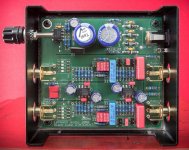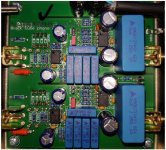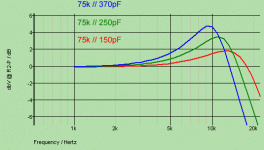Dear. I never wanted this topic to be so controversial.
My intention was for someone to explain to me because using the same vinyl record; the same magnetic capsule; the same amplifier; the same interconnection cables; the same acoustic boxes and the same listening room, there are differences in the dynamic range using different phono preamplifiers.
I refer to "dynamic range" to the difference between the light passages and the strong passages of the music. The difference between a whisper and a drum beat.
It shows the difference between different phono preamps can not be denied.
I saw someone asking what my modest audio system is.
AT 440 Mlb magnetic capsule; turntable direct drive Aiwa AP2400; integrated amplifier Marantz PM6006; Van den Hull cables c 122; acoustic boxes B & W DM602.
Phono preamps that I have used: Rotel RQ 970BX; NAD PP1; Pro Ject Phonobox MM-MC AC; VSPS400 (DIY); MUFFSY (DIY); P06 Rod Elliott (DIY); SOLIDPHONO published on TNT (DIY) (all DIY with fu; The phono preamplifier of the Marantz PM6006 integrated amplifier.
So I've been able to compare different preamplifiers (of course all low-end) and I've drawn the conclusion that some have "more life-more dynamic range than others.
Maybe I do not know how to express myself or there is a language barrier, but it's as simple as that. and my question was also simple: what makes the difference between one and the other
My intention was for someone to explain to me because using the same vinyl record; the same magnetic capsule; the same amplifier; the same interconnection cables; the same acoustic boxes and the same listening room, there are differences in the dynamic range using different phono preamplifiers.
I refer to "dynamic range" to the difference between the light passages and the strong passages of the music. The difference between a whisper and a drum beat.
It shows the difference between different phono preamps can not be denied.
I saw someone asking what my modest audio system is.
AT 440 Mlb magnetic capsule; turntable direct drive Aiwa AP2400; integrated amplifier Marantz PM6006; Van den Hull cables c 122; acoustic boxes B & W DM602.
Phono preamps that I have used: Rotel RQ 970BX; NAD PP1; Pro Ject Phonobox MM-MC AC; VSPS400 (DIY); MUFFSY (DIY); P06 Rod Elliott (DIY); SOLIDPHONO published on TNT (DIY) (all DIY with fu; The phono preamplifier of the Marantz PM6006 integrated amplifier.
So I've been able to compare different preamplifiers (of course all low-end) and I've drawn the conclusion that some have "more life-more dynamic range than others.
Maybe I do not know how to express myself or there is a language barrier, but it's as simple as that. and my question was also simple: what makes the difference between one and the other
The 4 DIYs that I mention are very good. You can see more dynamic range in Solidphono.
VSPS400 sounds wonderful; P06 Rod Elliott detailed but with slight accentuation at low frequencies; MUFFSY very good (it's the Audiokarma CNC).
I have tried all the mentioned in the audio system of a friend, much higher than the one I have, and I also notice the difference between one and another pre.
But this friend has a Lehmann Black Cube and surprise !!! EXPLOSION in every way. Incredible dynamic range.
That is what led me to ask the question that has brought so much controversy.
VSPS400 sounds wonderful; P06 Rod Elliott detailed but with slight accentuation at low frequencies; MUFFSY very good (it's the Audiokarma CNC).
I have tried all the mentioned in the audio system of a friend, much higher than the one I have, and I also notice the difference between one and another pre.
But this friend has a Lehmann Black Cube and surprise !!! EXPLOSION in every way. Incredible dynamic range.
That is what led me to ask the question that has brought so much controversy.
Your explanation now is much clearer, some of the controversy stemmed from the ambiguity of your first post and the fact that some people like to be controversial
Copper is good enough; silver is no better. Almost any plastic will do as insulator. The usual problem with bad cables is the construction/geometry e.g. omitting the shield from an unbalanced connection (thus inviting in RF), using braiding when twisting would be better and coax would be better still. If you can hear the difference between two short interconnects then at least one of them is faulty, and possibly the equipment too. However, let's not turn this into yet another cable thread.
My intention here is not to argue cables (nor to get advice on making them) but to get some sort of calibrating reference so I can understand your experience and position. If a Mexican tells me it's cold it can mean one thing, if a denizen of Snag,Yukon tells me, it probably means something else.
Cumbb, System that told you.Tornamesa Pro Ject Debut Carbon Spirit DC with Ortophon 2M Bronze capsule; Lehmann Black Cube; Rotel RCD 1070; Rotel RC 1070 and Rotel RB 1070; bicableado Van den Hull c122; acoustic boxes Martin Logan Classic ESL 9.
For my enviable and never attainable.

For my enviable and never attainable.

Last edited:
It may be that a fruitful way forward would be to consider what it might be about some phono preamps which gives the impression of enhanced dynamic range, even though if this was really happening it would mean that the preamp was faulty. Frequency response is one possible contender, given that some preamps have a poor adherence to RIAA and there is a poor correlation between RIAA accuracy and popularity/price.
At the end of the ESP article I linked to, Rod emphasises the importance of channel matching re the EQ as of more significance than strict adherence to the RIAA curve
The DIY that I have built I have done that. I have measured each passive component (resistors and capacitors) to match both L and R channels and to approximate the correct RIAA value
It may be that a fruitful way forward would be to consider what it might be about some phono preamps which gives the impression of enhanced dynamic range, even though if this was really happening it would mean that the preamp was faulty. Frequency response is one possible contender, given that some preamps have a poor adherence to RIAA and there is a poor correlation between RIAA accuracy and popularity/price.
Why are you impliying that a more lively sounding amp must be compromised? In my experience, it‘s the other way round: the better my gear specwise, the better the sound. Ever listened to a master tape? That‘s nirvana subjectivly and as objective you can get. Usually, the better the specs of your vinyl repro chain, the nearer you get to that master tape quality. You can get close, but you can never reach it (which makes sense, at least for vinyl).
It might be interesting to compare the response curves (R&L) of the ones you don't find dynamic
The triboelectric issues of silver/teflon are worse at lower signal levels, so a def no no for tonearm wiring. For audio silver has no magical properties. For RF cables it can be useful for a variety of reasons. Audio is not RF.
Considering the main areas for difference that might effect perception of dynamics we have
-gain
-RIAA accuracy
-cartridge loading
-overload margin
-subsonic performance
-noise
Of these I personally think that MM loading is the #1 culprit as a lot of phono stages will cause major deviations in response above 10kHz. A 5dB peak at 12kHz WILL be audible, but how it is perceived depends on a number of factors.
Overload margin is also important but I doubt there are many offenders in that area (happy to be wrong).
Gain will be picked up in comparisons if levels are not very carefully checked. Louder will sound 'more dynamic' in certain cases.
High noise floor will IME dampen dynamics, but it has to be very high.
And being heretical again. Live orchestral music IS dynamic, but it doesn't necessarily sound it. It sounds natural. There is a 'Hi-FI dynamic' which I have heard at shows which generally sends me running from the room. I have heard some like this!
Considering the main areas for difference that might effect perception of dynamics we have
-gain
-RIAA accuracy
-cartridge loading
-overload margin
-subsonic performance
-noise
Of these I personally think that MM loading is the #1 culprit as a lot of phono stages will cause major deviations in response above 10kHz. A 5dB peak at 12kHz WILL be audible, but how it is perceived depends on a number of factors.
Overload margin is also important but I doubt there are many offenders in that area (happy to be wrong).
Gain will be picked up in comparisons if levels are not very carefully checked. Louder will sound 'more dynamic' in certain cases.
High noise floor will IME dampen dynamics, but it has to be very high.
And being heretical again. Live orchestral music IS dynamic, but it doesn't necessarily sound it. It sounds natural. There is a 'Hi-FI dynamic' which I have heard at shows which generally sends me running from the room. I have heard some like this!
When we talk about topos i vote for high gain first stage which inherits the riaa high freq part done passive (pulling the output to ground via c-r in series) and a second stage with active feedback riaa for more akkurate bass response (shelve and 50,5 Hz pole) first stage discrete, second could be opamp like here (a worthwhile build, btw)
The subjectivly best slam had the phonoclone with AD811 in first stage, but its mc only. Second best in that regard, and overall more resolution is a complementary differential fet balanced input hung between beefy current mirrors like here (headamp only. Seems the first stage dominates not only noise but imprints its texture to the sound (hopefully faint). A perfect amp would not do that, of course.
The subjectivly best slam had the phonoclone with AD811 in first stage, but its mc only. Second best in that regard, and overall more resolution is a complementary differential fet balanced input hung between beefy current mirrors like here (headamp only. Seems the first stage dominates not only noise but imprints its texture to the sound (hopefully faint). A perfect amp would not do that, of course.
Dear. I never wanted this topic to be so controversial.
You must have not been a member here long!
Maybe I do not know how to express myself or there is a language barrier, but it's as simple as that. and my question was also simple: what makes the difference between one and the other
This was not an assault on your intelligence or a criticism of your English language skills.
More so a request for more clear information, so we can best answer your question.
You may feel your question is simple, but as a dozen or so pages of commentary show this is not the case.
For example, the gain setting of the black cube might be relevant, the different cartridge loading on the various stages, etc.
Most differences in perceived dynamics, as Bill pointed out, may not be because one stage is supremely better in design than the other.
The easiest way to a definitive answer to your question in this instance is to get some 30 second recording samples of each Phono stage you mentioned, and post them here, taking care to keep source material and all other system settings equal.
Last edited:
The first stage definitely puts the lower limit on the overall noise figure. But that much std txtbook stuff.
Member
Joined 2009
Paid Member
Of these I personally think that MM loading is the #1 culprit as a lot of phono stages will cause major deviations in response above 10kHz. A 5dB peak at 12kHz WILL be audible, but how it is perceived depends on a number of factors.
+1
Load the Magnets!!! - [English]
Attachments
- Status
- Not open for further replies.
- Home
- Source & Line
- Analogue Source
- How to get good dynamics in phono stage


